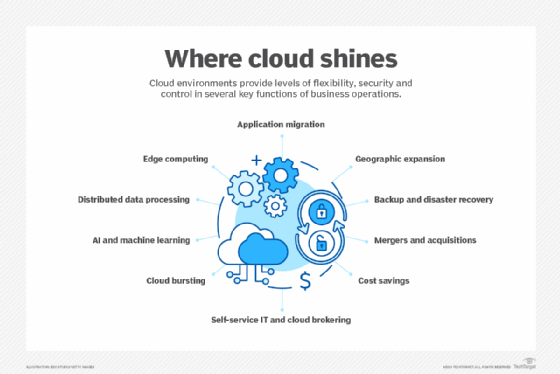Cloud networking vs. cloud computing: What's the difference?
Businesses might see cloud computing and cloud networking as interchangeable due to similarities, but the two strategies dictate different processes and fulfill different goals.
Cloud computing and cloud networking are related but distinct approaches. While cloud computing concerns how applications run, cloud networking covers how connectivity to and among applications is managed and delivered.
What is cloud computing?
Cloud computing shifts enterprise workload hosting from traditional in-house or collocated data centers to a cloud service provider's (CSP's) data center. The enterprise customer has no access to or direct control of the computing infrastructure underlying the services the workload runs on.
Cloud computing is delivered via different consumption models. There are three basic models for consuming cloud services, with each one providing customers with a different level of visibility into and control of their workloads. The models are as follows:
- Infrastructure as a service (IaaS) delivers a hypervisor layer on which customers provision VMs. Customers can also monitor their workloads from the OS level up.
- Platform as a service (PaaS) delivers access to a middleware environment -- such as a database, a container hosting and management environment or a Java application server -- in which customers can deploy applications. Customers can monitor the behavior of their workloads within the middleware environment but can't see anything beneath or outside that environment.
- Software as a service (SaaS) delivers access to a running application, and customers can only monitor their own user, data and configuration information within that application space. Customers can't see the cloud environment within which that application runs.
Cloud computing benefits and challenges
The following are among the many benefits of cloud computing.
Organizations can respond to new opportunities more quickly
Agility is the cloud's true superpower. New technology stacks can be spun up in hours on IaaS, new development environments can be operational in minutes with PaaS, and new applications for users can be available in minutes using SaaS.
Data can be accessed from anywhere, at any time, using the internet
Access can also be achieved with on-premises deployments, but this requires significantly more work on the part of network, security and systems teams. Network teams need to ensure there's adequate bandwidth to handle average traffic as well as sudden spikes in use. Security teams must have the correct access controls in place so each user sees only what they should. Systems teams must have the underlying platform always up and running, have enough excess capacity to handle sudden increases in usage and allow for capacity to be added before it's exhausted -- without buying more capacity than is needed. In a cloud platform, all the problems of scaling and traffic management are offloaded to the CSP, as is maintenance of the systems enforcing access control policies.
Data can be recovered quickly in an emergency
Cloud platforms can generally restore backup data more quickly than on-premises infrastructure can, especially if the material to be restored in the on-premises scenario has been moved off-site for disaster recovery purposes. Cloud backups are typically found in online or nearline storage and can be reached with a few mouse clicks.

However, cloud computing does have its challenges, including the following.
Not all workloads are suited to the cloud
Workloads written to scale horizontally to meet dynamic demand can benefit from using a cloud service provider's resources and can cost less to run in the cloud. Applications -- usually legacy apps -- built to scale vertically, to be always on and running, or with all potentially needed resources allocated all the time aren't well suited to the cloud model and often cost less to run on-premises.
Concerns over how sensitive information is handled
The cloud platform is typically a black box, with customers knowing only what the provider chooses to reveal about the platform and no way to verify the information. This level of trust can be offset, to some extent, by contractual terms and independent audits.
Difficulty finding employees with the skills to manage cloud systems
IT teams often have a hard time getting or retaining enough staff with specialist knowledge of each cloud's platform-specific way of accomplishing necessary system, network and security functions. This is especially the case for multi-cloud and hybrid cloud environments. Implementing the same policies can require very different approaches across the various environments.
Switching CSPs can cause migration and data access issues
One major factor many organizations don't consider is the cost of migrating data out of a cloud environment. These costs can be significant if the amount of data is large, and the more data there is, the more time it will take to extract it all. In addition, many providers don't offer proof of deletion for all copies of data deleted on their platform. An organization might have to accept the possibility of old copies of their data still floating around in backup media somewhere.
What is cloud networking?
Cloud networking involves shifting network management, control and even data connectivity to an external cloud infrastructure. Cloud networking uses cloud services to control network traffic and connect network resources.
Cloud networking examples include the following:
- The use of cloud-based network controllers to manage wireless LANs. Cloud-based management is increasingly common for enterprise wireless LANs (WLANs) and even campus and data center networks. It removes the burden of keeping management platforms up to date and simplifies vendor support. Vendors also use data acquired from the many networks managed to train AI systems to assist in network management, provide predictive analytics around performance and maintenance, and offer better insight into traffic management.
- The use of cloud-based network controllers for an SD-WAN, SASE or a full network as a service. SD-WAN and SASE connect multiple locations, including data centers, cloud environments and sometimes extranet links to client partners. Using cloud services to manage these is a good fit architecturally. A full cloud-provisioned network as a service (NaaS) is the next logical step, shifting all remaining WAN infrastructure -- aside from the minimum required to connect to a NaaS provider's point of presence -- to the provider cloud to take advantage of its staff expertise, CSP interconnects and cloud-level scaling for firewalls.
- The use of a CSP's internal WAN to carry enterprise WAN traffic among locations. Especially when coupled with a NaaS platform, this can remove the need to either provision private links for WAN traffic from region to region, or cloud to cloud, or to trust such traffic to the public internet. Instead, it uses a CSP's own backbones and nonpublic internet peering used by major providers that is better managed and provisioned than the best-effort public internet.
When compared to a traditional network, cloud networking can replace the management plane for any part of a network architecture without affecting network performance, as well as the control plane for WAN and intercloud segments.
Cloud networking benefits and challenges
The benefits of cloud networking include the following.
Reduces the complexity of on-premises network equipment and software
Each site needs routers or similar endpoint nodes to connect to the provider service, but other functions, such as load balancing and firewalling, can be shifted to the cloud service.
CSPs handle system updates, freeing your staff for higher-priority tasks
A complex enterprise WAN often requires a great deal of maintenance work to keep software patched and up to date. In many organizations, the bulk of that work isn't automated and is subject to the risks of incomplete or inconsistent execution of the update process and any subsequent configuration changes that might be needed.
It's easy to scale operations in the cloud
Adding a new cloud environment to an existing NaaS environment can be as simple as clicking a few buttons, extending the existing policy to it and adding any configurations specific to the new resources. In the case of a merger or acquisition, establishing a link from the acquired company's infrastructure is just as easy, with the NaaS provider taking on the burden of temporary measures, such as large-scale network address translation and segmenting traffic for security purposes, until resources are more fully vetted and assimilated.
However, the following challenges can occur with cloud networking infrastructure.
Vendor lock-in
There are currently no standards to interconnect NaaS offerings or migrate management data from one SD-WAN or WLAN cloud management platform to another. This means the greater the commitment to a platform, the greater the effort needed to migrate out of it. It might even be necessary to spin up a new environment in all sites and clouds in parallel with the old environment before moving sites over.
Providers must fix connectivity or uptime issues
The flip side of offloading infrastructure and interconnect concerns is that an organization has no control over solving problems directly with the CSP. This has always been an issue with WAN connectivity or networking within a cloud, but it's a new concern for areas that can be managed traditionally, such as WANs and WLANs.
Comparing cloud computing vs. cloud networking
There's a natural overlap between cloud computing and cloud networking: Anyone using a cloud computing platform via IaaS uses cloud networking to connect VMs in that environment to each other, other cloud services and the internet. In a hybrid cloud, enterprises use cloud networking to interconnect cloud resources with internal systems in data centers.
In a modern hybrid network, it's typical to shift some functions that would be delivered by network appliances in a legacy network to the cloud. A company might migrate its global load balancer from a data center to an IaaS environment, for example, or switch to a function-as-a-service model as part of a broader push to NaaS.
What might lead your organization to adopt cloud networking?
Nearly all organizations use cloud computing, and the drive to become more agile, force updates to aging applications and get out of a capital-intensive service model will continue to push folks to the technology. Newer companies might never have a data center of their own.
A smaller number of organizations use cloud networking outside the context of their cloud computing environments, but several trends are increasing that percentage, including the following:
- The number of organizations using multiple IaaS platforms. The complexity of interconnecting those environments to each other and to on-premises networks makes cloud services more attractive. Mergers and acquisitions almost always mean increasing the number of cloud environments in use.
- The rapid rise of zero-trust network access services to replace traditional VPNs. ZTNA services can also replace private WAN connectivity for small-to-midsize branches, and significant savings can often be achieved.
- The spread of security service edge and secure access service edge. Cloud networks providing significant security infrastructure, with or without SD-WAN services, can make it faster and easier for an enterprise to extend SSE and SASE protections and controls to their entire environment.
- The continuing spread of cloud-managed WLANs. Adopting cloud-managed WLAN shifts some of the enterprise-grade WLAN management and maintenance burden from overburdened IT teams to the service provider. This approach also provides a direct and easy path to piloting and possibly adopting AI in network management.
Editor's note: This article was updated in January 2025 to provide additional information on the benefits and challenges of cloud computing and cloud networking and to improve the reader experience.
John Burke is CTO and principal research analyst with Nemertes Research. With nearly two decades of technology experience, he has worked at all levels of IT, including end-user support specialist, programmer, system administrator, database specialist, network administrator, network architect and systems architect.







